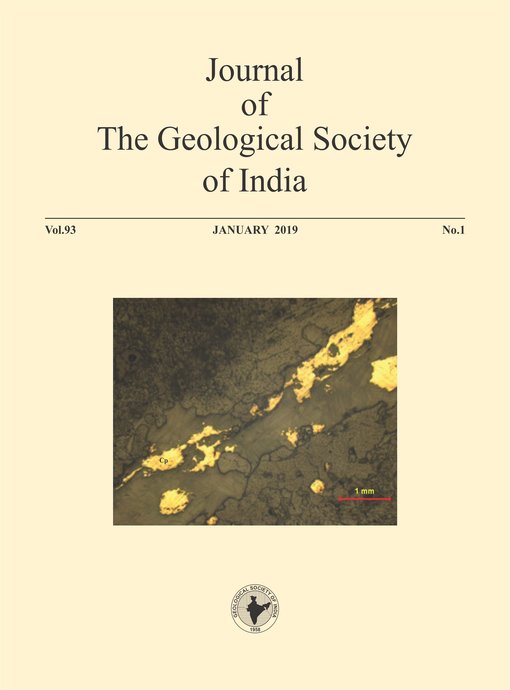Studies on Toxicity of Fluoride and Impact of Endemic Fluorosis from Groundwater Resources of Bagalkot District, Karnataka – Geospatial Information System Approach
DOI:
https://doi.org/10.1007/s12594-019-1129--5Abstract
Fluorine is most electronegative element, never occurs in free state due to its high reactivity. In most of the places of the world drinking water from underground sources is invariably contaminated with fluoride. The concentration of fluoride according to the WHO standard allowed upper limit is 1.5 ppm whereas as per Indian standard, the allowed upper limit is 1.0 mg/litre. Fluoride ion gets contaminated in drinking water due to weathering of the soil and rocks and the groundwater sources of granite belt of Bagalkot district, contain much higher concentration of fluoride (up to 6 or 7 ppm). In this survey it is found that the concentration of fluoride even at 1.34 ppm has caused tooth decay with the permanent brown scales on the teeth.Downloads
Metrics
Issue
Section
Downloads
Published
How to Cite
References
APHA (1995) Standard methods for the examination of water and wastewater, 19th edn. American Public Health Association, Washington, DC
Athavale, R.N. and Das, R.K. (1999) Beware! Fluorosis is zeroing in on you. Down to Earth v.8, pp.24–25.
Bureau of Indian Standards. (1993) Indian Standard Specifications for Drinking Water IS: 10500.
CGWB (2011) Groundwater information booklet, Bagalkot dist., Karnataka.
Chakraborti, D., Chanda, C.R., Samanta, G., Chowdhury, U.K., Mukherjel, S.C. and Pal, A.B. (2000) Fluorosis in Assam, India. Curr. Sci., v.78, pp.1421–1423
Deshmukh, A.N., Valadaskar, P.M. and Malpe D.B. (1995) Fluoride in environment: a review. Gondwana Geol. Magz., v.9, pp.1–20
Handa, B.K. (1975) Geochemistry and genesis of í»uoride contains groundwater in India. Ground Water, v.13, pp.275–281
Hem, J.D. (1959). Study and interpretation of the chemical characteristics of natural water (No. 1473). US Government Printing Office.
Indian Standard Institution (ISI),(1991):Indian standard specification for drinking water, IS-10500.
Kantharaja, D.C., Lakkundi, T.K., Basavanna, M. and Manjappa, S. (2012) Spatial analysis of fluoride concentration in ground waters of Shivani watershed area, Karnataka state, South India, through geospatial information system, Environ. Earth Sci., v.65 pp.67-76
Kalshetty, B.M., Shobha, N., Kalashetti, M.B. and Gani R.S., (2014) Water quality of river Tungabhadra due to the discharge of industrial effluent at Harihar, district Davanagere, Karnataka, India. American Journal of Advanced Drug Delivery, v.2(1) pp.120-132.
Kumar, P.S. (2012) Assessment of fluoride contamination in groundwater as precursor for electrocoagulation. Bull. Environ. Contam. Toxicol., v.89(1), pp.172-175.
Kundu, M.C. and Mandal, B. (2009) Assessment of potential hazards of fluoride contamination in drinking groundwater of an intensively cultivated district in West Bengal, India. Environ. Monit. Assess., v.152(1), pp.97103.
Languir, D. (1997) Aqueous Environmental Chemistry, Prentise-Hall, Inc, New Jersey.
Muralidharan, D., Nair, A.P. and Satyanarayana, U. (2002) Fluoride in shallow aquifers in Rajgarh tehsil of Churu district, Rajasthan” an arid environment. Curr. Sci., v.83 pp.699–702.
Pillai, K.S. and Stanley, V.A. (2002) Implications of fluoride”an endless uncertainty. Jour. Environ. Biol., v.23 pp.81–97.
Rama Rao, N.V. (1982) Geochemical factors iní»uencing the distribution of í»uoride in rocks, soils, and water sources of Nalgonda district. Doctoral Thesis, Osmania University, India. pp. 320
Subba Rao, N.S. (1992). Factors Affecting Optimum Development of Ground waters in Crystalline Terrain of the Eastern Ghats, Vishakhapatnam Area, Andhra Pradesh, India. Jour. Geol. Soc. India, v.40(5) pp.462-467.
Saxena, V. and Ahmed, S. (2003) Inferring the chemical parameters for the dissolution of fluoride in groundwater. Environ. Geol., v.43(6), pp.731736.
Sharma, B.S., Agrawal, J. and Gupta, A.K. (2011) Emerging challenge: fluoride contamination in groundwater in Agra district, Uttar Pradesh. Asian Jour. Exp. Biol. Sci., v.2(1), pp.131-134.
Susheela, A.K. (1999) Fluorosis management programme in India. Curr. Sci., v.77, pp.1250–1256
Trivedi, R.K. and Goel, P.K. (1984) Chemical and biological methods for pollution. Environmental Publication, Karad, India.
World Health Organization (1963). Guidelines for drinking water quality: International Standards for Drinking water, world health organization, 2nd edition
WHO (2005) World Health Organization's recommendations for drinking water.
World Health Organization. (2016) WHO.(2011) Guidelines for drinking-water quality. World Health Organization, Geneva.
Yu, Y.W. Yang, Z. Dong (2000) Fluoride Research Report, P33.Treatise on Fluorosis, Fluorosis Research and Rural Development Foundation, Delhi, 2007.

 S. M. Gaonkar
S. M. Gaonkar






